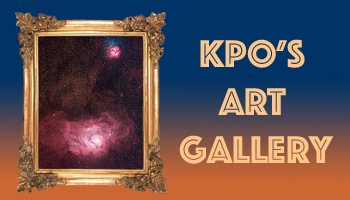Caught on a rare clear summer night in Central Florida, here is the Lagoon Nebula / Messier 8 (bottom) and the Trifid Nebula / Messier 20 (top). Both M8 and M20 are star-forming regions, with M8 showing off all its Bok globules (the small dark pockets of dust and gas), which are cocoons for infant stars, just forming.
Within the Lagoon nebula is the open cluster NGC 6530, just to the left of the brightest area of nebulosity. The Lagoon Nebula is estimated to be between 4,000–6,000 light-years away from the Earth. From our perspective, it spans 90′ by 40′, which translates to an actual dimension of 110 by 50 light years. Three full moons would fit within its confines in the sky,
The Trifid Nebula is a unique structure in that it is composed of emission, reflection and dark nebulae, all collected around an open star cluster. The emission nebula is the glowing reddish pink circle, the reflection nebula is the blue gas & dust seen just above the emission neb, and the dark nebula are the lanes of dark obscuring dust that appears to cut the emission nebula into 3 parts. The dark dust is actually positioned in front of the emission nebula. The Trifid lies about 4100 light years from Earth.
The nebulosity positioned between the Lagoon and the Trifid is Sharpless 2-28, a faint emission nebula – thew region is loaded with gas and dust as it is located right near the core of our Milky Way galaxy.
This is an HaRGB image, which is true color, but using Hydrogen Alpha light as the main luminance channel. I was pleasantly surprised to get this good of an image since there is only 90 minutes of color data that was captured (30 minutes each: R,G,B). There was an hour of Hydrogen alpha light captured, and that was used as the Luminance channel.
Click on the image to see a larger version you can explore.
Image Info
- Imaged from the KPO field in Saint Cloud, Florida.
- Camera : ZWO ASI1600MM Pro, Gain set to 200
- Lens: Canon 100-400 f/5.6L lens, set to 400mm
- Mount: iOptron SmartEQ Pro
- Red: 6 subframes of 300s = 30 min integration
- Green: 6 subframes of 300s = 30 min integration
- Blue: 6 subframes of 300s = 30 min integration
- Luminance: 12 Ha subframes of 300s = 60 min integration
- Total integration time: 150 min = 2.5 hours.
- Captured via ASIAir Pro automation
- Optical tracking via ASIAir automation, currently using ST4 mount control via the ASI120MM-S guide camera
- Separate channels stacked and HaRGB integrated in Astro Pixel Processor
- Image cropped, stretched, and noise processed in Nebulosity.
- Final processing in Aperture
Buy this image as a print or framed art piece in our Art Gallery.


